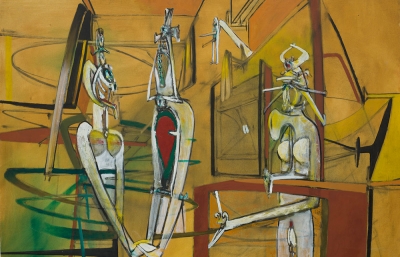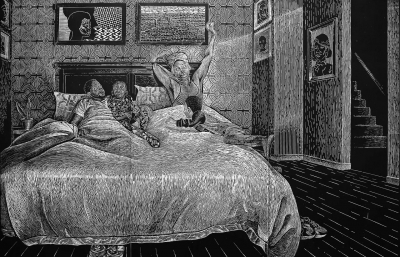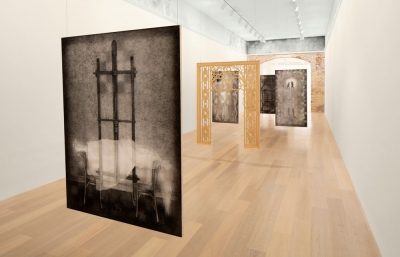Academy of Art University’s Spring Show takes place annually—yes, in the Spring—and continues to thrive, despite this being 2020! What has traditionally been an extravaganza of student work from the school’s 75 disciplines, exhibited in an exhibition hall for a month, is still blooming, but can currently be viewed on The Academy's website. While previous shows provided students with the chance to exchange business cards with industry functionaries, this wide-open online showcase is on the virtual runway 24/7, providing viewers with unlimited time to thoroughly view genres from painting to landscape design to video games, including personal portfolios and opportunities to get in touch.
Academy of Art University and Juxtapoz are native to the streets of San Francisco we both call home, but also share an international reach, nurturing a growing, world-wide cultural landscape. While we can’t shout out everyone, we want to profile a few of the students and their submissions for the Spring Show, which participant Yujin Kim said, “allowed me the opportunity to engage and enjoy the work of other students, which influenced me to grow as an artist.” So, in a nod to their School of Entertainment, which includes film, and in the spirit of the Spring Show, remember the words of actor Audrey Hepburn, that “To plant a garden is to believe in tomorrow.”
Yujin Kim—An Old Car in the Forest
Yujin Kim grew up studying piano and ballet in South Korea, but it was painting and drawing that brought the most satisfaction, and seeing Iron Man that powered her way to The Academy in San Francisco. “I can still remember the first day I learned 3D software, and when I thought about building a portfolio to showcase my first job, I decided a car as the main object. The first car I created was a completely shiny, luxury car, but I wanted to challenge myself …” Because the scene is unexpected, that is a challenge in itself. Accustomed as we are to animation that is future centric, urbanized, and by virtue of its meaning, a projection of motion, Kim’s An Old Car in the Forest makes its initial impact with what we perceive as something in the past. Dirt streaked windows, a severed bumper and rust caked paint encrust with the patina of age, as the dreary, hospital gown green vehicle decays amidst sun dappled woods in a scene of abandonment and mystery. Starting with the model of an old Ford, she builds upon the object, blending colors, surfaces and settings to convey passage of time, the degradation of weather and possible effects of—in a collision with the tree—impact? Credit Kim’s skill and imagination as an environmental and character texture artist who makes us wonder about making a scene with no identifiable protagonist that possesses stillness and memory with the distinct possibility of action to come. 
Carolina Marquez—Working Women Lead the Way
Carolina Marquez feels lucky to have had the support of a family of makers who delved into both tattoo and fine art, but it’s clear that movies, tv and cartoons informed her skill set. The work, made for the Western Service Workers Association calendar pulses with a communal vibration, most probably inspired by the day Carolina spent volunteering with them. This piece started “with just a pen and the same sketchbook I brought with me,” eventually amounting to more than twenty drawings she winnowed down, reshaped and reformed over and over until choosing a sketch that best captured the mood and subject. After refining the illustration with iPad and Procreate, literally drawing more women into the picture, she was able to project strength, enthusiasm and pride into a connected crowd. A particular angular jaw or curly coif conveys adds appeal. A baby on the shoulder indicates the responsibility of working mothers. No one woman stands out. The choice of earthy browns, clay reds and drab green don’t thrust any one person into the spotlight. The women may toil unnoticed, but in bestowing each of them with alert, dark eyes and sturdy bodies, they are ready for action, Marquez achieves the WSWA’s theme that “Working Women Lead the Way” as the best illustrations should, clearly, memorably and with instant appeal. 
Tirdad Aghakhani—LOST
“Some of my artist friends gave critiques saying my pictures didn’t look like formal photographs, but more like paintings or somewhere in between.” Luckily, Tirdad Aghakhani understood the wealth of possibilities if he continued on that two lane highway. In fact, that’s the road he pursued in the haunting Lost collection of meditative pictures shot in California and the southwestern states. An immigrant from Iran, Aghakhani acknowledges the immediate connectivity of the digital age, but fights the loneliness of feeling on the outside. He goes in search of America, truly capturing places with his camera, imprinting these locations with his “inside” by double exposing them with his own x-rays, the result of injuries from a car accident. Brilliant, saturated colors burst with the beautiful promise of life in a new country, while the quiet landscapes whisper of solitary moments, momentarily imprinted by the x-rays floating through places like an unrecognizable Houston where a cobalt blue sky, rivaling Starry Night, rests on a field of coppery browns, the bones of his chest like so may bent trees. The stark white x-ray of his outstretched palm imposes like the hand of god over a ghostly farm house in Point Reyes. Throughout this striking series, Aghaktani shows us a poignant catalog of his journey to discover a new country, stop and savor nature, which has no borders and present our collective wish to be remembered.
Xinyi Shen—Hacking Darwin
In attempting to solve the structural problem of mobile parts moving autonomously without compromising the entire mechanism, the inventor Erno Rubik devised his ubiquitous, six color classic cube. For Hacking Darwin, Xinyi Shen imagined a scenario demonstrating various combinations (choices?) of genetic contributions—and painted it. “I chose a Rubik’s cube as the metaphor for my concept, and how cool would that be if every side stood for a different genetic characteristic?” It is very cool that she accomplished the portrayal, especially since Kim admits that most of her prior work involved more painterly illustrations. In experimenting with a more graphic style, she portrays an ethical question visually, and compellingly, so it can be better understood, enjoyed and, in turn, revisited. The cube is twisted open to display all six representative colors and their characteristics, the result of Shen’s palette choice and spatial harmony. Two doctors, carefully masked, represent not only the evolving science and technology, but hopefully, the watchful eyes of ethical consideration. Painting Hacking Darwin digitally allowed her to manipulate the images, the size and position of the doctors, for example, and in the end, make a satisfying work of art. “For me, I love to create metaphors to make people think, and I hope to build a connection between artwork and readers.”
Jessica Galvan—The Buena Vista Trading Station
For Jessica Galvan, it all started with popsicle sticks, and this final review ends with popsicle sticks! One of the delicious advantages of slurping an orange or raspberry frozen treat was that you end up with a very useful, portable tool. Not only a keepsake of delicious memory, two or two thousand of them can be made into something. As a child, Jessica Galvan dreamed of having a dollhouse, so she and her dad spent “countless afternoons” trying to build one, for, as she explains. “Fabrication for me is all about being creatively resourceful, repurposing what you have to create a little reality.” Galvan’s Spring Show piece is an ode to stop-motion, miniature scaled, many-faceted sets from which props and puppets are fashioned, one photographed frame at a time, to create the impression of movement. Inspired by the askew look of Laika Studio’s ParaNorman, little thumbnail sketches became the mockup of foam core, which helped define the structure. Modeling her creative resourcefulness, materials were chosen to be lightweight, interlocking and portable. With a firmly laid base and illustration board atop, Galvan glued dollhouse siding, molding, popsicle sticks (!) and 1,374 individual shingles to complete her 20th century wartime merchant trade station. Essential to any animation film is a set that lays the foundation for time, place and mood, as she accomplished with her woodworking, sculpting, soldering and painting skills.
Jessica spoke for all students involved in this Academy of Art University tradition, concluding that, “Over time my piece went through changes and evolutions, just how I did. Overall, my Spring Show piece was my way of showcasing my journey. Thanking everyone that helped me along the way.”























